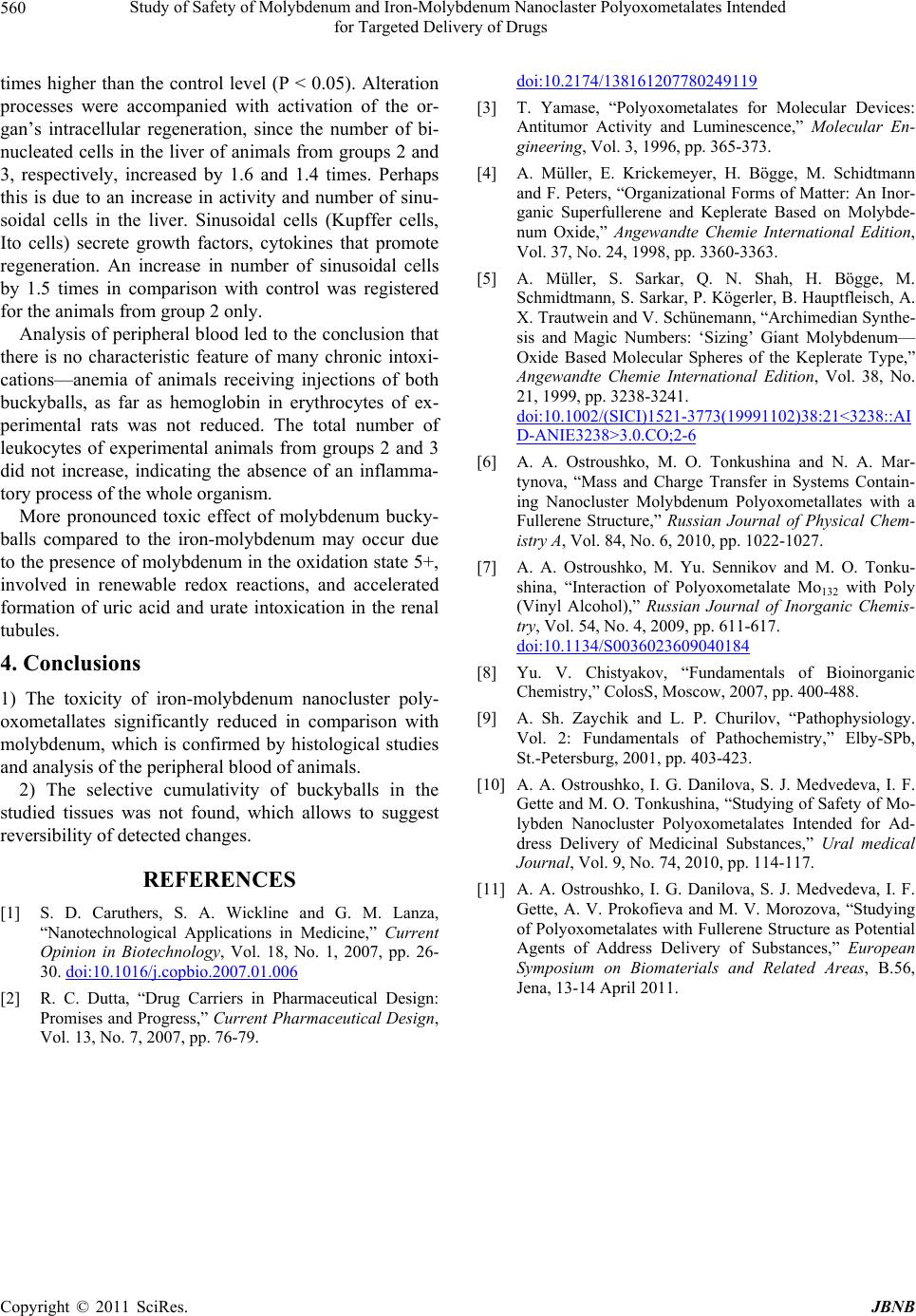
Study of Safety of Molybdenum and Iron-Molybdenum Nanoclaster Polyoxometalates Intended
for Targeted Delivery of Drugs
Copyright © 2011 SciRes. JBNB
560
times higher than the control level (P < 0.05). Alteration
processes were accompanied with activation of the or-
gan’s intracellular regeneration, since the number of bi-
nucleated cells in the liver of animals from groups 2 and
3, respectively, increased by 1.6 and 1.4 times. Perhaps
this is due to an increase in activity and number of sinu-
soidal cells in the liver. Sinusoidal cells (Kupffer cells,
Ito cells) secrete growth factors, cytokines that promote
regeneration. An increase in number of sinusoidal cells
by 1.5 times in comparison with control was registered
for the animals from group 2 only.
Analysis of peripheral blood led to the conclusion that
there is no characteristic feature of many chronic intoxi-
cations—anemia of animals receiving injections of both
buckyballs, as far as hemoglobin in erythrocytes of ex-
perimental rats was not reduced. The total number of
leukocytes of experimental animals from groups 2 and 3
did not increase, indicating the absence of an inflamma-
tory process of the whole organism.
More pronounced toxic effect of molybdenum bucky-
balls compared to the iron-molybdenum may occur due
to the presence of molybdenum in the oxidation state 5+,
involved in renewable redox reactions, and accelerated
formation of uric acid and urate intoxication in the renal
tubules.
4. Conclusions
1) The toxicity of iron-molybdenum nanocluster poly-
oxometallates significantly reduced in comparison with
molybdenum, which is confirmed by histological studies
and analysis of the peripheral blood of animals.
2) The selective cumulativity of buckyballs in the
studied tissues was not found, which allows to suggest
reversibility of detected changes.
REFERENCES
[1] S. D. Caruthers, S. A. Wickline and G. M. Lanza,
“Nanotechnological Applications in Medicine,” Current
Opinion in Biotechnology, Vol. 18, No. 1, 2007, pp. 26-
30. doi:10.1016/j.copbio.2007.01.006
[2] R. C. Dutta, “Drug Carriers in Pharmaceutical Design:
Promises and Progress,” Current Pharmaceutical Design,
Vol. 13, No. 7, 2007, pp. 76-79.
doi:10.2174/138161207780249119
[3] T. Yamase, “Polyoxometalates for Molecular Devices:
Antitumor Activity and Luminescence,” Molecular En-
gineering, Vol. 3, 1996, pp. 365-373.
[4] A. Müller, E. Krickemeyer, H. Bögge, M. Schidtmann
and F. Peters, “Organizational Forms of Matter: An Inor-
ganic Superfullerene and Keplerate Based on Molybde-
num Oxide,” Angewandte Chemie International Edition,
Vol. 37, No. 24, 1998, pp. 3360-3363.
[5] A. Müller, S. Sarkar, Q. N. Shah, H. Bögge, M.
Schmidtmann, S. Sarkar, P. Kögerler, B. Hauptfleisch, A.
X. Trautwein and V. Schünemann, “Archimedian Synthe-
sis and Magic Numbers: ‘Sizing’ Giant Molybdenum—
Oxide Based Molecular Spheres of the Keplerate Type,”
Angewandte Chemie International Edition, Vol. 38, No.
21, 1999, pp. 3238-3241.
doi:10.1002/(SICI)1521-3773(19991102)38:21<3238::AI
D-ANIE3238>3.0.CO;2-6
[6] A. A. Ostroushko, M. O. Tonkushina and N. A. Mar-
tynova, “Mass and Charge Transfer in Systems Contain-
ing Nanocluster Molybdenum Polyoxometallates with a
Fullerene Structure,” Russian Journal of Physical Chem-
istry A, Vol. 84, No. 6, 2010, pp. 1022-1027.
[7] A. A. Ostroushko, M. Yu. Sennikov and M. O. Tonku-
shina, “Interaction of Polyoxometalate Mo132 with Poly
(Vinyl Alcohol),” Russian Journal of Inorganic Chemis-
try, Vol. 54, No. 4, 2009, pp. 611-617.
doi:10.1134/S0036023609040184
[8] Yu. V. Chistyakov, “Fundamentals of Bioinorganic
Chemistry,” ColosS, Moscow, 2007, pp. 400-488.
[9] A. Sh. Zaychik and L. P. Churilov, “Pathophysiology.
Vol. 2: Fundamentals of Pathochemistry,” Elby-SPb,
St.-Petersburg, 2001, pp. 403-423.
[10] A. A. Ostroushko, I. G. Danilova, S. J. Medvedeva, I. F.
Gette and M. O. Tonkushina, “Studying of Safety of Mo-
lybden Nanocluster Polyoxometalates Intended for Ad-
dress Delivery of Medicinal Substances,” Ural medical
Journal, Vol. 9, No. 74, 2010, pp. 114-117.
[11] A. A. Ostroushko, I. G. Danilova, S. J. Medvedeva, I. F.
Gette, A. V. Prokofieva and M. V. Morozova, “Studying
of Polyoxometalates with Fullerene Structure as Potential
Agents of Address Delivery of Substances,” European
Symposium on Biomaterials and Related Areas, B.56,
Jena, 13-14 April 2011.